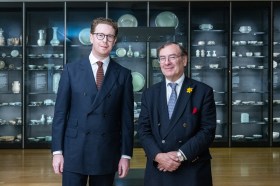How long does it take to hop over the channel these days? Trains and boats and planes have made Normandy as accessible and as quickly reached as, say, Manchester is from London. So why don’t you go? If you need an arts-based excuse, try this for size: the Chateau de Bray at Forges-les-Eaux has been staging a Picasso exhibition since 17th May and it runs until 31st August. Forges is about 2 hours drive from Boulogne, rather less from Dieppe, and sits in the heart of the cider and cheese making area of Pays de Bray. The chateau is of modest proportions and archetypal, sporting pepper-pot turrets at four corners. Each year a major exhibition is held, featuring past masters. Last year it was Dali and one of his sculptures, the white rhinoceros, still stands outside the main front where it is now harried by several brightly coloured metal vaches.
Picasso has never produced the goods for me despite having stood in front of the Demoiselles d’Avignon in New York and wandered around the museum dedicated to him in Paris. Nothing resonated. That is until last week when I was simply bowled over by the twenty or so large scale stained glass pieces in this exhibition. Produced in two years between 1955 and 1957, along with forty others, they don’t use the traditional single thickness and lead jointing that is expected of stained glass, but are richly three dimensional, being fixed with a colourless glue during construction, the finished pieces having a colourless liquid enamel poured over them before being fired in an oven. The result of this painstaking process is that the images jump out and hit you smack in the face. They have more depth than any of his paintings or sculptures and yet the subject matter is his own work. They are copies or extracts from paintings made years or decades previously and all are absolutely stunning. After seeing these pieces I am a true convert. For all his faults, the man was indeed a genius.
Each work is composed of many thousands of shards of coloured glass, each one hand placed. There must have been some blood spilt in the process, and not just the artist’s own but of his several helpers – for without a team working on the project it would have taken immeasurably longer to achieve. Although there were high hopes for what Picasso himself called this new art, it seems to have fallen out of favour quite quickly, no doubt because of the incredible effort necessary. The surge of interest in the sixty pieces produced by a magical outpouring from the century’s acknowledged master artist, was insufficient to sustain and nourish the new art. Instead we have these few gems marking a moment in time and comprising a period in Picasso’s own development.
The chateau is at 106 route de Paris (the D915) about two miles south of Forges-les-Eaux. Details of the exhibition can be seen at www.artdif.com. Entry is 5€ and there are concessions for under 18s. Under 10s go free. I would strongly recommend a visit, whatever view you currently hold on Picasso.




